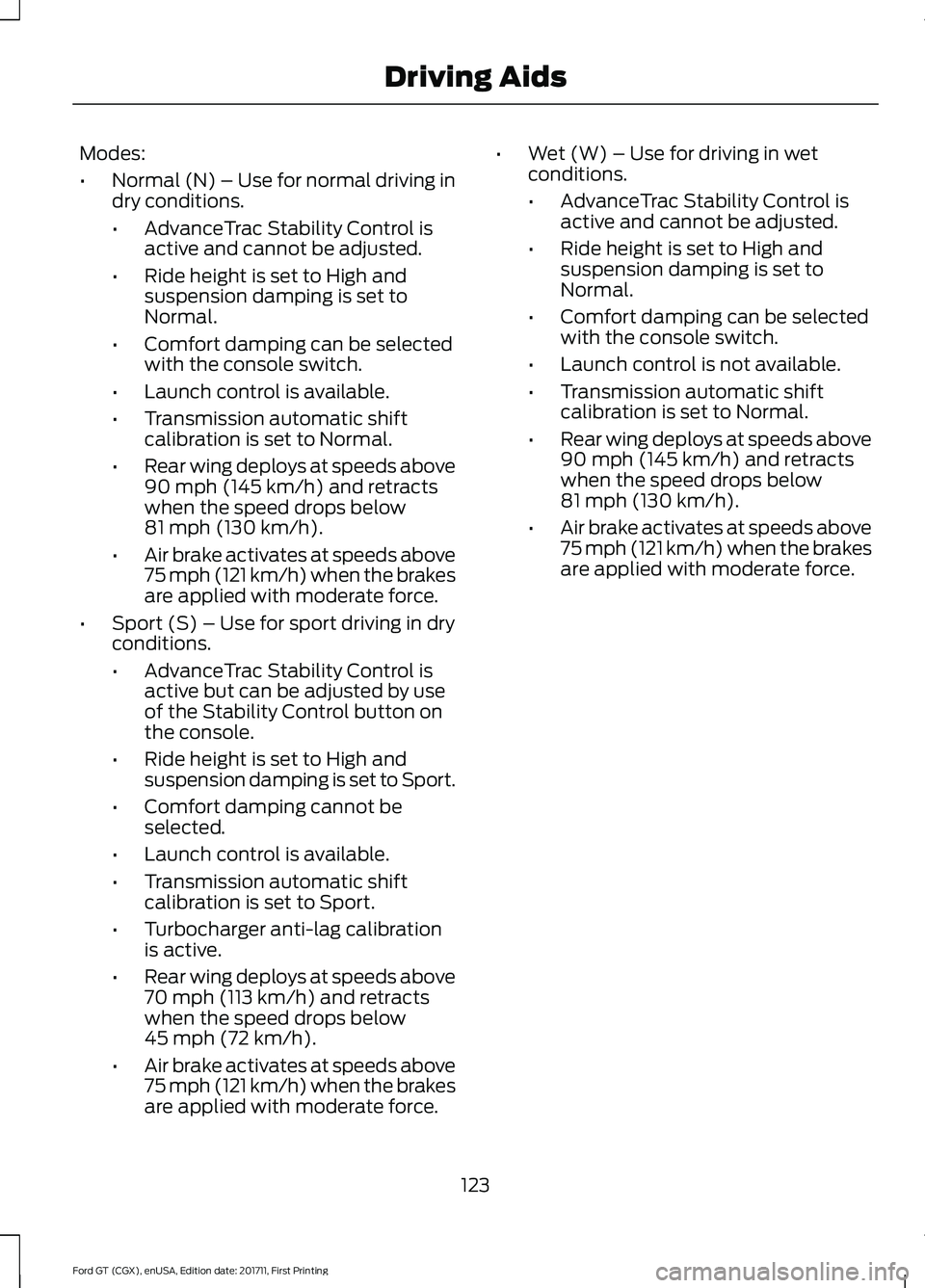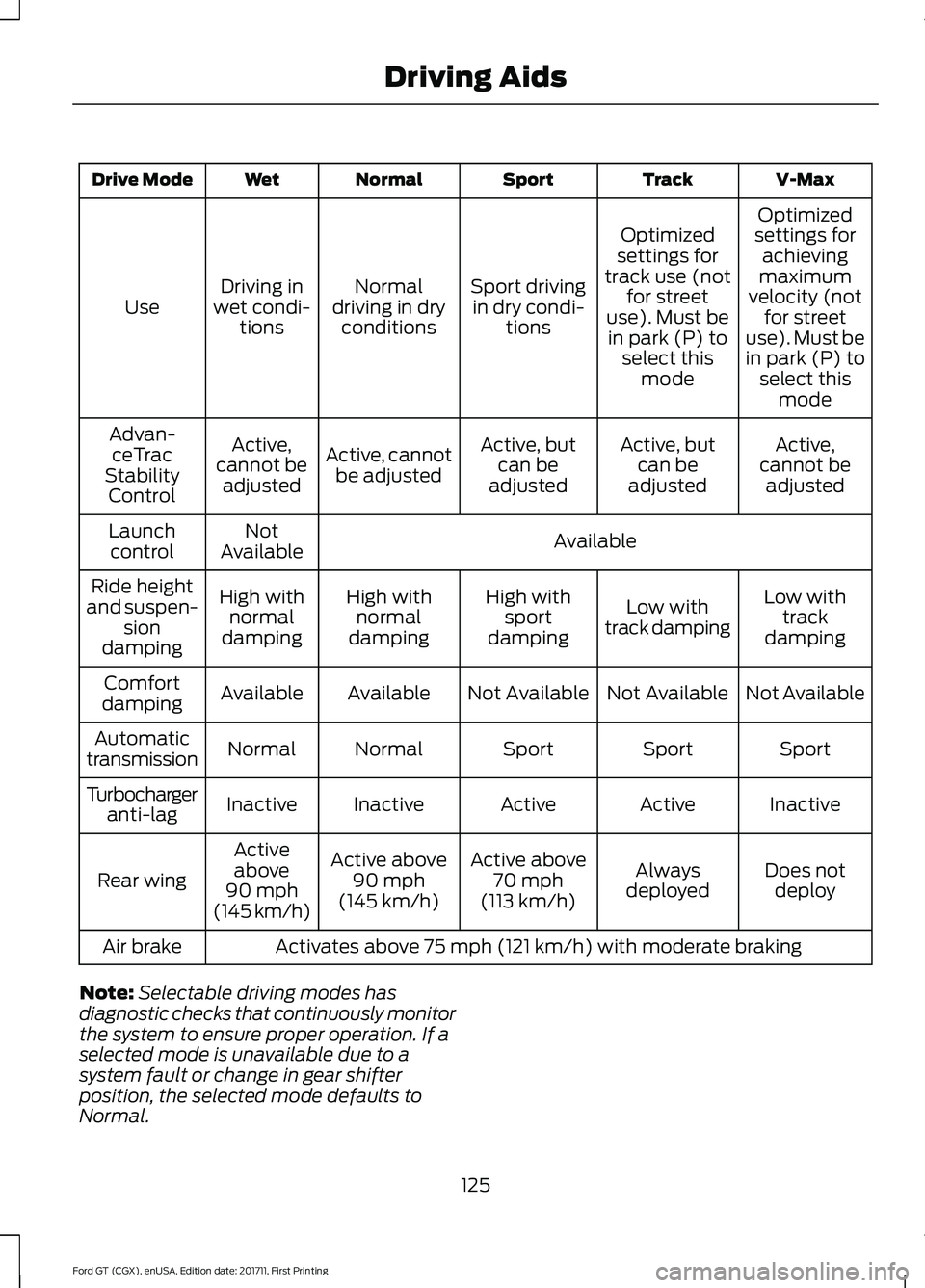2018 FORD GT transmission
[x] Cancel search: transmissionPage 125 of 325

STEERING
To help prevent damage to the power
steering system:
•
Never hold the steering wheel at its
furthest turning points (until it stops)
for more than three to five seconds
when the engine is running.
• Do not operate the vehicle with a low
hydraulic fluid level. See Power
Steering Fluid Check (page 167).
• Some noise is normal during operation.
If excessive, check for low hydraulic
fluid level before seeking service by
your dealer.
• Heavy or uneven efforts may be caused
by low hydraulic fluid. Check for low
hydraulic fluid level before seeking
service by your dealer.
• Do not over fill the hydraulic fluid as
this may result in leaks from the
reservoir. See
Power Steering Fluid
Check (page 167).
If the power steering system breaks down
(or if the engine is off), you can manually
steer the vehicle, but it takes more effort.
If the steering wanders or pulls, check for:
• An improperly inflated tire.
• Uneven tire wear.
• Loose or worn suspension
components.
• Loose or worn steering components.
• Improper vehicle alignment.
A high crown in the road or high crosswinds
may also make the steering seem to
wander or pull. DRIVE MODE CONTROL
Drive Mode Selection
Your vehicle has five selectable drive
modes that deliver an enhanced driving
experience through a suite of sophisticated
electronic vehicle systems. In response to
vehicle use and driving conditions, the
selection of the drive mode optimizes
handling and powertrain response. This
provides a single location to control
multiple systems performance settings.
Using Selectable Drive Modes
To change the drive mode setting, use the
rotary switch on the left side of the steering
wheel.
Note:
To engage or disengage Track or
V-Max Drive Modes, the car must be at a
stop with the transmission in park (P) and
the engine running. This is necessary since
the vehicle ride height changes. You can
change between Normal, Wet and Sport
Drive Modes while the vehicle is in motion.
122
Ford GT (CGX), enUSA, Edition date: 201711, First Printing Driving AidsE227821
Page 126 of 325

Modes:
•
Normal (N) – Use for normal driving in
dry conditions.
•AdvanceTrac Stability Control is
active and cannot be adjusted.
• Ride height is set to High and
suspension damping is set to
Normal.
• Comfort damping can be selected
with the console switch.
• Launch control is available.
• Transmission automatic shift
calibration is set to Normal.
• Rear wing deploys at speeds above
90 mph (145 km/h) and retracts
when the speed drops below
81 mph (130 km/h)
.
• Air brake activates at speeds above
75 mph (121 km/h) when the brakes
are applied with moderate force.
• Sport (S) – Use for sport driving in dry
conditions.
•AdvanceTrac Stability Control is
active but can be adjusted by use
of the Stability Control button on
the console.
• Ride height is set to High and
suspension damping is set to Sport.
• Comfort damping cannot be
selected.
• Launch control is available.
• Transmission automatic shift
calibration is set to Sport.
• Turbocharger anti-lag calibration
is active.
• Rear wing deploys at speeds above
70 mph (113 km/h)
and retracts
when the speed drops below
45 mph (72 km/h)
.
• Air brake activates at speeds above
75 mph (121 km/h) when the brakes
are applied with moderate force. •
Wet (W) – Use for driving in wet
conditions.
•AdvanceTrac Stability Control is
active and cannot be adjusted.
• Ride height is set to High and
suspension damping is set to
Normal.
• Comfort damping can be selected
with the console switch.
• Launch control is not available.
• Transmission automatic shift
calibration is set to Normal.
• Rear wing deploys at speeds above
90 mph (145 km/h)
and retracts
when the speed drops below
81 mph (130 km/h)
.
• Air brake activates at speeds above
75 mph (121 km/h) when the brakes
are applied with moderate force.
123
Ford GT (CGX), enUSA, Edition date: 201711, First Printing Driving Aids
Page 127 of 325

•
Track (T) – Optimized settings for
track handling performance. The Track
drive mode should only be used in a
track environment, not on the street,
due to the low ride height. This setting
can only be selected while your vehicle
is in park (P) with the engine running,
and you need to confirm the selection.
•AdvanceTrac Stability Control is
active but can be adjusted by use
of the Stability Control button on
the console.
• Ride height is set to Low and
suspension damping is set to Track.
• Comfort damping cannot be
selected due to low ride height.
• Launch control is available.
• Transmission automatic shift
calibration is set to Sport.
• Turbocharger anti-lag calibration
is active.
• Rear wing deploys and remains
deployed while in Track mode.
When you change to another mode,
the wing lowers once you start to
drive your vehicle, not while it is
stopped.
• Air brake activates at speeds above
75 mph (121 km/h) when the brakes
are applied with moderate force. •
V-Max (V) – Optimized settings for
achieving maximum velocity (top
speed). The V-Max mode should only
be used in a controlled track
environment, not on the street, due to
the low ride height. This setting can
only be selected while your vehicle is
in park (P) with the engine running, and
you need to confirm the selection.
•AdvanceTrac Stability Control is
active and cannot be adjusted.
• Ride height is set to Low and
suspension damping is set to Track.
• Comfort damping cannot be
selected due to low ride height.
• Launch control is available.
• Transmission automatic shift
calibration is set to Sport.
• Rear wing does not deploy.
• Air brake activates at speeds above
75 mph (121 km/h) when the brakes
are applied with moderate force.
Note: When you shut down your vehicle in
V-Max or Track mode, the vehicle returns
to the Normal ride height. When you restart
your vehicle in V-Max or Track mode, you
need to re-acknowledge the drive mode
selection in the information display in order
for the drive mode to reactivate. If you do
not make a selection, the vehicle returns to
the previously selected drive mode.
124
Ford GT (CGX), enUSA, Edition date: 201711, First Printing Driving Aids
Page 128 of 325

V-Max
Track
Sport
Normal
Wet
Drive Mode
Optimized
settings for achieving
maximum
velocity (not for street
use). Must be
in park (P) to select this mode
Optimized
settings for
track use (not for street
use). Must be in park (P) to select this mode
Sport driving
in dry condi- tions
Normal
driving in dry conditions
Driving in
wet condi- tions
Use
Active,
cannot be adjusted
Active, but
can be
adjusted
Active, but
can be
adjusted
Active, cannot
be adjusted
Active,
cannot be adjusted
Advan-
ceTrac
Stability Control
Available
Not
Launch
control Available
Low withtrack
damping
Low with
track damping
High with
sport
damping
High with
normal
damping
High with
normal
damping
Ride height
and suspen- sion
damping
Not Available
Not Available
Not Available
Available
Available
Comfort
damping
Sport
Sport
Sport
Normal
Normal
Automatic
transmission
Inactive
Active
Active
Inactive
Inactive
Turbocharger
anti-lag
Does notdeploy
Always
deployed
Active above
70 mph
(113 km/h)
Active above
90 mph
(145 km/h)
Active
above
90 mph
(145 km/h)
Rear wing
Activates above 75 mph (121 km/h) with moderate braking
Air brake
Note: Selectable driving modes has
diagnostic checks that continuously monitor
the system to ensure proper operation. If a
selected mode is unavailable due to a
system fault or change in gear shifter
position, the selected mode defaults to
Normal.
125
Ford GT (CGX), enUSA, Edition date: 201711, First Printing Driving Aids
Page 140 of 325

Should your vehicle shut off after a crash,
you may restart your vehicle.
1. Press START/STOP to switch off your
vehicle.
2. Press the brake pedal and START/STOP
to switch on your
vehicle.
3. Remove your foot from the brake pedal
and press
START/STOP to switch off
your vehicle.
4. You can attempt to start the vehicle by pressing the brake pedal and
START/STOP
, or press START/STOP
without pressing the brake pedal.
Note: Both methods re-enable the fuel
system.
JUMP STARTING THE VEHICLE WARNINGS
Do not use fuel lines, engine valve
covers, windshield wiper arms, the
intake manifold, or hood latch as
ground points. Use only adequately sized cables
with insulated clamps.
Preparing Your Vehicle
Note:
Attempting to push-start a vehicle
with an automatic transmission may cause
transmission damage.
Note: Use only a 12-volt supply to start your
vehicle.
Note: Do not disconnect the battery of the
disabled vehicle as this could damage the
vehicle's electrical system.
Park the booster vehicle close to the hood
of the disabled vehicle, making sure the
two vehicles do not touch. Connecting the Jumper Cables
1. Switch off all accessories.
2. Remove the red cap over the positive
(B) post of the disabled vehicle.
3. Connect the positive (+) jumper cable
to the positive (B) post of the disabled
vehicle.
4. Connect the other end of the positive (+) cable to the positive terminal of the
booster vehicle battery.
5. Connect the negative (-) jumper cable
to the negative (A) post of the disabled
vehicle.
6. Connect the other end of the negative (-) cable to the negative terminal of
the booster vehicle battery.
Grounding Stud Location 137
Ford GT (CGX), enUSA, Edition date: 201711, First Printing Roadside EmergenciesE235907 E229889
Page 142 of 325

Getting the Transmission in
Neutral
If the battery loses charge, the
transmission will be in park (P). You can
use the transmission tool to place the car
into Neutral (N). See Automatic
Transmission (page 106).
TOWING POINTS
Recovery Hook Location
Your vehicle comes with a screw-in
recovery hook, it is in the storage
compartment under the rear hatch.
Installing the Recovery Hook
Note: The screw-in recovery hook has a
left-hand thread. Turn it counterclockwise
to install it. Make sure that the recovery
hook is fully tightened.
The installation point for the recovery hook
is the receptacle in the right corner of the
front grille. 139
Ford GT (CGX), enUSA, Edition date: 201711, First Printing Roadside EmergenciesE233260
Page 152 of 325

Protected Components
Fuse Rating
Fuse or Relay
Number
Vehicle power 3.
15A 1
1
Mass airflow.
5A 1
2
Engine control module.
10A 1
3
Transmission control module.
5A 1
4
Vehicle power 1.
20A 1
5
Keep alive power.
5A 1
6
Not used.
—
7
Rear video camera.
5A 1
8
Not used.
—
9
Alternator sense.
10A 1
10
Air conditioner.
10A 1
11
Damper.
10A 1
12
Vehicle power 4.
15A 1
13
Not used.
—
14
Battery backup sounder.
5A 1
15
Engine control module.
5A 1
16
Run/start.
Vehicle power 2.
20A 1
17
Injector.
15A 1
18
Fuel pump 1.
30A 2
19
Fuel pump 2.
30A 2
20
Transmission control module.
30A 2
21
149
Ford GT (CGX), enUSA, Edition date: 201711, First Printing Fuses
Page 154 of 325

Protected Components
Fuse Rating
Fuse or Relay
Number
Transmission gear fluid cooler fan relay.
—
1
Engine oil cooler fan relay.
—
2
Transmission clutch fluid cooler fan relay.
—
3
Not used.
—
4
Not used.
—
5
Not used.
—
6
Engine oil cooler fan.
20A 1
7
Transmission clutch fluid cooler fan.
30A 1
8
Transmission gear fluid cooler fan.
20A 1
9
Not used.
—
10
1 J-case low profile fuse.
Passenger Compartment Fuse
Panel
The fuse panel is in the passenger footwell
behind the toeboard panel.
151
Ford GT (CGX), enUSA, Edition date: 201711, First Printing FusesE270327